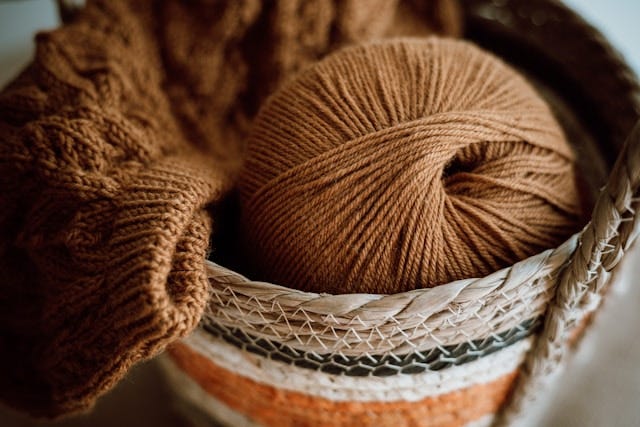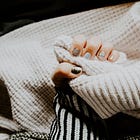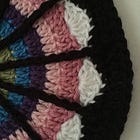Knitting Heals: Interview with Stroke Survivor Rebecca Robinson
Followed by related excerpts from my research and writing for the book Crochet Saved My Life: The Mental and Physical Health Benefits of Crochet
This article originally appeared on the PsychCentral blog Crafting to Heal which I wrote for in 2019. Since the blog has since been archived, I have some posts related to craft as therapy from that archive that I want to share here on Substack, beginning with this one. I’ve added relevant excerpts from my book Crochet Saved My Life to complement the interview.
In response to some of the work I’ve been doing about crafting to heal, I received a wonderful comment from Rebecca Robinson about how knitting heals as a form of physical / occupational therapy, which she herself used after a stroke and brain bleed. Interestingly, she wasn’t able to use crochet the same way. I wanted to know more and was thrilled when she agreed to an interview.
Knitting Immediately After a Stroke
Rebecca first shared that she had a stroke and accompanying brain bleed in August 2018. She said that the very first thing she did the day of her stroke was to ask for her knitting. Despite having severe difficulties in cognitive thought and hand-eye coordination, Rebecca was able to knit. Her doctors were amazed.
It helped a lot that she had a nurse who was also a knitter. Rebecca is forever grateful for the time that nurse spent helping her work through the pattern, get the needles in place, and complete those early stitches.
Rebecca can’t remember the nurses name but says,
“I owe her a great deal for her help, love and understanding. She shared what I was doing with several others and they all came in to check my progress and to encourage me when I was having trouble.”
Interview About How Knitting Heals
Rebecca obviously already knew how to knit when she had her stroke. She had learned from a neighbor in Holland sometime around the age of nine years old. Before the stroke, she definitely enjoyed the craft. She especially loved that she was able to use her skills to provide gifts of sweaters, afghans, stockings, and so forth to all of her family members. However, she never knew how much knitting would come to help her after the stroke.
What can you share about the experience of having the stroke?
It was frightful! I was terrified at first due to the limits of my manual dexterity, memory loss, and struggles with cognitive reasoning. I couldn’t control my needles and yarns, couldn’t read the symbols on my patterns, and had trouble putting colors together.
What inspired you to immediately ask for your knitting when you were in recovery?
My husband had previously had a stroke and the one thing I knew from his experience was to “jump right back in.” It’s important to regain your lost skills as quickly as possible.
In what ways has knitting helped your recovery?
Knitting helped me immediately with physical therapy to regain some of my coordination and hand movements. My return to knitting also helped my speech because I would practice reading the patterns aloud. I can also say that my math skills are better now, too, thanks to the practice of counting stitches and rows.
I believe it was equally important that knitting offered a reduction of stress and improved positive mental health during this tough time. When I had my stroke I was very depressed. Using the knitting as therapy has helped me to relax, find myself again, recover most of my long term memory, and improve my short term memory, too.
“I can once again shop for yarn/patterns, socialize with other knitters, and be proud of my accomplishment when I finish a project and give it as a gift.”
My skills aren’t where they were before the stroke. However I have not lost those skills. I’ve just temporarily misplaced them.
How have you kept up with knitting since leaving the hospital?
I have joined a local knitting group and the ladies there are continuing to help me slog my way through as knitting heals me day by day. My husband has termed this my “String Therapy.”
Can you explain a little bit more about why it’s still hard to crochet even though you can knit?
I’m not sure if I can actually. I crochet edges on things but the hand/eye coordination is still not there. I am also still having difficulty reading the patterns. But, if I am shown how to do the pattern, then I can readily pick it up again. It has been an interesting aspect of this recovery process. I’m glad that I was familiar with both crafts so that I had options when the stroke happened.
What else would you like to share?
I want to thank those at HSHS St. John’s Hospital for their care and help and Decatur Memorial Hospital Physical Therapy Dept. for not discouraging me, but actually encouraging me, to knit as physical and mental health therapy. I also really appreciate my speech therapist who help me to read and understand my patterns. She was also a knitter! Most of all, I want to thank my family and husband who cheered me on daily and continue to do so as I continue to rebuild myself.
I will always look at my knitting as a way of saying thanks to all of these people for helping me to regain what could have easily been lost. Truly, knitting heals us in so many ways and I’m grateful for that.
Related Excerpts from Crochet Saved My Life
“Notably, meditation also assists in growing or retaining brain volume. As we’ve seen, many people say that they achieve effects similar to those of meditation when they are immersed in their crochet stitching. This suggests that crochet may be valuable to brain growth not only because it offers the opportunity to engage the brain with new learning but also because it offers the option to engage in the repetitive, meditative type of crochet that many of us enjoy even when not learning a new stitch technique. Betsan Corkhill of Stitchlinks explains that,
“The automatic nature of knitting in particular means that often those suffering from dementia remember the process of knitting. They may not be able to follow or process a pattern but they’ll often remember how to knit.”
Stitchlinks’ research has also found that people who have suffered strokes but who are physically still able to knit report an improvement in memory and concentration attributed to their knitting. The conclusion can be drawn that similar memory-protective benefits may apply to crochet.”
“Crochet can also be used to treat the hands when they have sustained some type of injury, in which case it is considered a form of occupational therapy. Types of injuries that might require this type of therapy include disabilities caused by strokes and repetitive stress injuries like those seen in carpal tunnel syndrome. In many cases, what you’re trying to do here is rebuild the fine motor skills. Crafting is used in occupational therapy settings to help develop fine motor skills. In fact, a 1981 study by Bissell and Mailloux on the use of crafts in occupational therapy for the physical disabled ranked the number one reason to use crafts as the fact that it improves fine motor control. Crafts can be used in occupational therapy treatment for patients of all ages. Young patients suffering from developmental disabilities may be behind in their motor skill development and can use crochet to practice those skills. Older people may lose some of their fine motor skills due to other health conditions, such as strokes, and they can also use crochet as part of their occupational therapy program.”
If you read this far, perhaps you liked the work. The work does take work. It only continues with support, so please consider subscribing. My annual rate starts at $10 per year.









